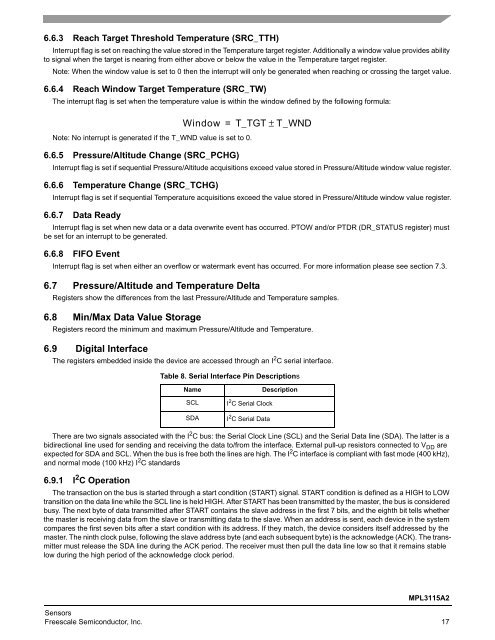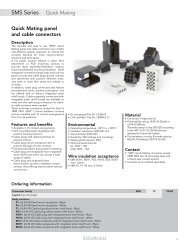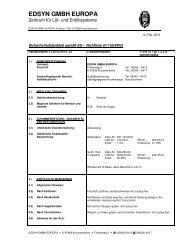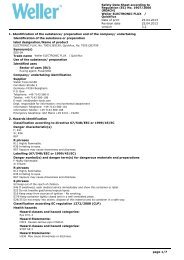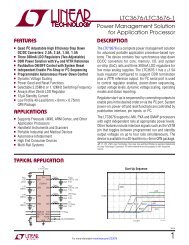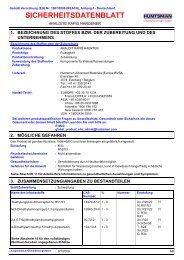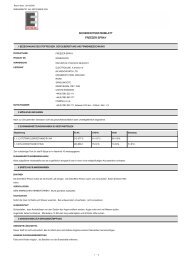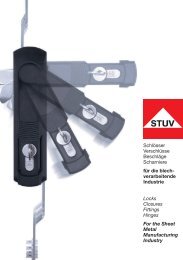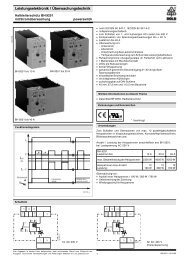I C Precision Altimeter - Farnell
I C Precision Altimeter - Farnell
I C Precision Altimeter - Farnell
You also want an ePaper? Increase the reach of your titles
YUMPU automatically turns print PDFs into web optimized ePapers that Google loves.
6.6.3 Reach Target Threshold Temperature (SRC_TTH)<br />
Interrupt flag is set on reaching the value stored in the Temperature target register. Additionally a window value provides ability<br />
to signal when the target is nearing from either above or below the value in the Temperature target register.<br />
Note: When the window value is set to 0 then the interrupt will only be generated when reaching or crossing the target value.<br />
6.6.4 Reach Window Target Temperature (SRC_TW)<br />
The interrupt flag is set when the temperature value is within the window defined by the following formula:<br />
Note: No interrupt is generated if the T_WND value is set to 0.<br />
6.6.5 Pressure/Altitude Change (SRC_PCHG)<br />
Interrupt flag is set if sequential Pressure/Altitude acquisitions exceed value stored in Pressure/Altitude window value register.<br />
6.6.6 Temperature Change (SRC_TCHG)<br />
Interrupt flag is set if sequential Temperature acquisitions exceed the value stored in Pressure/Altitude window value register.<br />
6.6.7 Data Ready<br />
Interrupt flag is set when new data or a data overwrite event has occurred. PTOW and/or PTDR (DR_STATUS register) must<br />
be set for an interrupt to be generated.<br />
6.6.8 FIFO Event<br />
Interrupt flag is set when either an overflow or watermark event has occurred. For more information please see section 7.3.<br />
6.7 Pressure/Altitude and Temperature Delta<br />
Registers show the differences from the last Pressure/Altitude and Temperature samples.<br />
6.8 Min/Max Data Value Storage<br />
Registers record the minimum and maximum Pressure/Altitude and Temperature.<br />
6.9 Digital Interface<br />
Window = T_TGT ± T_WND<br />
The registers embedded inside the device are accessed through an I 2 C serial interface.<br />
Table 8. Serial Interface Pin Descriptions<br />
Name<br />
SCL<br />
SDA<br />
I 2 C Serial Clock<br />
I 2 C Serial Data<br />
Description<br />
There are two signals associated with the I 2 C bus: the Serial Clock Line (SCL) and the Serial Data line (SDA). The latter is a<br />
bidirectional line used for sending and receiving the data to/from the interface. External pull-up resistors connected to V DD are<br />
expected for SDA and SCL. When the bus is free both the lines are high. The I 2 C interface is compliant with fast mode (400 kHz),<br />
and normal mode (100 kHz) I 2 C standards<br />
6.9.1 I 2 C Operation<br />
The transaction on the bus is started through a start condition (START) signal. START condition is defined as a HIGH to LOW<br />
transition on the data line while the SCL line is held HIGH. After START has been transmitted by the master, the bus is considered<br />
busy. The next byte of data transmitted after START contains the slave address in the first 7 bits, and the eighth bit tells whether<br />
the master is receiving data from the slave or transmitting data to the slave. When an address is sent, each device in the system<br />
compares the first seven bits after a start condition with its address. If they match, the device considers itself addressed by the<br />
master. The ninth clock pulse, following the slave address byte (and each subsequent byte) is the acknowledge (ACK). The transmitter<br />
must release the SDA line during the ACK period. The receiver must then pull the data line low so that it remains stable<br />
low during the high period of the acknowledge clock period.<br />
MPL3115A2<br />
Sensors<br />
Freescale Semiconductor, Inc. 17


